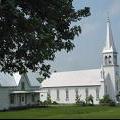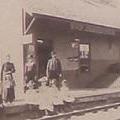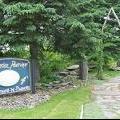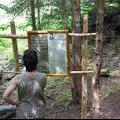 Nestled in the hills not far from the Canada-U.S. border at East Hereford is the tiny hamlet of Saint-Venant-de-Paquette. Saint-Venant, or Paquetteville, as many of the locals still call it, has a population of 111, making it one of the smallest municipalities in the Eastern Townships. It is also, arguably, one of the most pretty. This corner of the Townships is a little off the beaten track, but that should not deter visitors from making the trip. In fact, Saint-Venant's out-of-the-way feel only adds to its charm, and the village is well worth a visit, not only for the splendid, unspoiled scenery, but for the remarkable heritage site that has been created here.
Nestled in the hills not far from the Canada-U.S. border at East Hereford is the tiny hamlet of Saint-Venant-de-Paquette. Saint-Venant, or Paquetteville, as many of the locals still call it, has a population of 111, making it one of the smallest municipalities in the Eastern Townships. It is also, arguably, one of the most pretty. This corner of the Townships is a little off the beaten track, but that should not deter visitors from making the trip. In fact, Saint-Venant's out-of-the-way feel only adds to its charm, and the village is well worth a visit, not only for the splendid, unspoiled scenery, but for the remarkable heritage site that has been created here.
PROSPERITY
Settled by French Canadian Catholics in the 1860s, the village of Saint-Venant soon became the centre of a larger parish of the same name, which encompassed most of the old township of Hereford. Most of the amenities were available in the little community: post office, general store, grocery, blacksmith, flour and saw mills, bakery, shoemaker, and in 1907, the first rural Caisse populaire (a kind of community-run bank) in North America. There was also a convent and, of course, the parish church. Thanks to an expanding forestry industry, Saint-Venant prospered, with growth peaking in the early 1900s. Capitalizing on the logging trade with New Hampshire, the Hereford Railway built a line through Saint-Venant, making regular stops in the village.
 DECLINE
DECLINE
In the early decades of the 20th century, the village began a long period of decline. The railway closed its station in 1925, and development of the road network led to the closure of the entire line a short time after that. The population of Saint-Venant decreased. The Caisse populaire closed in 1974, and the historic convent building (1879) burned down in 1995.
REBIRTH
In recent years, something remarkable has happened in this little town. In 1998, a small group of concerned citizens formed a non-profit association, Les Amis du patrimoine de Saint-Venant ("the friends of heritage"), with the goal of developing the heritage and culture of the village. Since then, the group has accomplished much, and has actually turned this tiny village into something unique in the province.
 SAINT-VENANT CHURCH: A JEWEL IN WOOD
SAINT-VENANT CHURCH: A JEWEL IN WOOD
Begun in 1877 and finished twenty years later by the architect Jean-Baptiste Verret, the Catholic church of Saint-Venant is a spectacular sight. Managed by Les Amis du patrimoine since 1998, it is today both a functioning church and a museum. The second floor balcony, which is the only one in Quebec to circle the entire church, serves as the museum, and features a permanent exhibition on the architecture and religious artifacts of the church and the history of Saint-Venant.
Saint-Venant Church is quite large for such a small community. It is especially remarkable for the quality of its interior workmanship. But even more unusual is the fact that the interior is designed entirely of varnished woodwork, which (probably thanks to costs that were prohibitive for this small parish) has never been painted or altered in any way, and which retains all of its original beauty.
From floor to ceiling and everything in between -- mouldings, walls, arches, vaults, altar, pews -- all were lovingly crafted by local artisans of woods found in the area. All are as they were over a hundred years ago. The natural light that streams in through the large neo-Gothic windows gives the whole church a rich golden hue. The effect is breathtaking, and indeed, few churches can compare!
Masses in the church are celebrated at 10:30 a.m., from the first Sunday in May to the first Sunday after Labour Day, and on major Church holidays. As well, concerts are held at different times throughout the summer.
 THE "HOUSE OF THE TREE"
THE "HOUSE OF THE TREE"
A small pavilion, the Maison de l'arbre ("The House of the Tree"), is adjacent to the church, and is the starting point for most visits to Saint-Venant. The pavilion houses a permanent exhibition on the forest, a boutique, a café, washroom facilities, and a terrace with a view of a pond. Guides are on hand to answer questions. The terrace of the Maison de l'arbre is an excellent place to relax with a picnic, and the atmosphere is very laid-back.
 THE "POETIC TRAILS"
THE "POETIC TRAILS"
The Sentiers poétiques, or "Poetic Trails," are the brainchild of popular Quebec singer and local resident Richard Séguin, and a labour of love of countless volunteers. A series of landscaped walking paths, they meander through flower gardens, forests, and in and around the church and village.
Inscribed on interpretive panels at different spots along the way are excerpts from the works of the major French-language poets of Quebec: Félix Leclerc, Gilles Vigneault, Madame Bolduc, Émile Nelligan, and others. Along the paths, in peaceful, contemplative surroundings, one will also discover beautiful horticultural displays and unusual sculptures in stone. The concept is unique in Quebec, if not the world.
Saint-Venant is located just off Route 253, near the New Hampshire border.